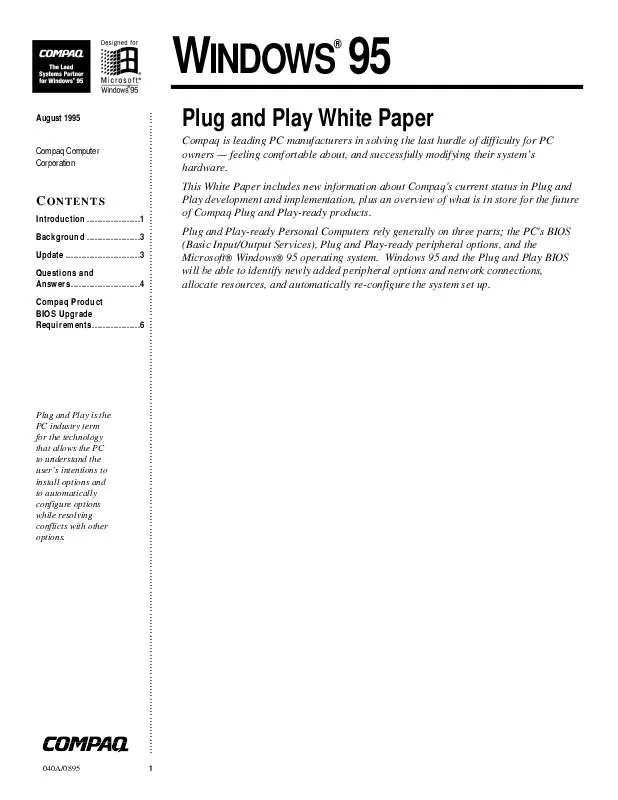Detailed instructions for use are in the User's Guide.
[. . . ] Compaq does not warrant products other than its own strictly as stated in Compaq product warranties. Product names mentioned herein may be trademarks and/or registered trademarks of their respective companies. Compaq, Contura, Deskpro, Fastart, Compaq Insight Manager, LTE, PageMarq, Systempro, Systempro/LT, ProLiant, TwinTray, LicensePaq, QVision, SLT, ProLinea, SmartStart, NetFlex, DirectPlus, QuickFind, RemotePaq, BackPaq, TechPaq, SpeedPaq, QuickBack, PaqFax, registered United States Patent and Trademark Office. Aero, Concerto, QuickChoice, ProSignia, Systempro/XL, Net1, SilentCool, LTE Elite, Presario, SmartStation, MiniStation, Vocalyst, PageMate, SoftPaq, FirstPaq, SolutionPaq, EasyPoint, EZ Help, MaxLight, MultiLock, QuickBlank, QuickLock, TriFlex Architecture and UltraView, CompaqCare and the Innovate logo, are trademarks and/or service marks of Compaq Computer Corporation. [. . . ] By continuing to work closely with Microsoft, Compaq ensures its Plug and Play-ready PCs to be fully compatible with the Windows 95 operating system. Compaq also established extensive compatibility testing support to Independent Hardware Vendors (IHVs) in major Plug and Play interoperability workshops, such as the Plug and Play Association's PlugFest. These activities add to Compaq's solid Plug and Play background and build upon its earlier influence in establishing the Plug and Play Specification. Making its public debut at the Microsoft WinHEC show in February 1994, the Compaq LTE Elite notebook PC was used by Microsoft to demonstrate another Plug and Play feature and a PCindustry first - "warm-docking" using the Windows 95 operating system. Warm docking is a Plug and Play feature referring to the notebook automatically docking or seating into a docking station while the notebook PC is in the standby power conservation state. The Plug and Play BIOS is compatible with several bus architectures including ISA, PCMCIA, and PCI. EISA-based products already operate in a Plug and Play manner and do not need a Plug and Play BIOS. Compaq contributed significant technology and industry standardization to the EISA standard, and is now building on its industry leadership by bringing this Plug and Playtype technology in an updated form into the Plug and Play Specification. During the development of Microsoft Windows 95, Compaq fine-tuned the Plug and Play BIOS. Previous BIOS editions included versions . 98 and 1. 0. Since 1994 Compaq has been shipping products with the 1. 0a BIOS, which is fully forward compatible with any new Windows 95 iteration. Compaq committed to bring this technology to market as quickly as possible, and is prepared to provide this forward compatibility to customers.
040A/0895
3
WINDOWS® 95 (cont. )
. .
Plug and Play White Paper
What will happen next?
All shipping Compaq products incorporate the 1. 0a Plug and Play BIOS. Compaq and Microsoft continue to work closely together with all major independent hardware vendors to ensure that their upcoming peripheral options will be fully compatible with Compaq PCs running Windows 95.
QUESTIONS A N D ANSWERS
1. Is there a way to have Plug and Play with Windows 3. 1?
Compaq developed an exclusive Plug and Play solution for Windows 3. 1 by providing Computer Setup for Windows (CSW) 2. 0. Intended to provide users Plug and Play features before availability of Windows 95, CSW 2. 0 supports the auto-configuring and conflict resolution of Plug and Play ISA boards. In combination with the Plug and Play BIOS, CSW 2. 0 provides the highest level of Plug and Play support available under Windows 3. 1.
2. Can products without the Plug and Play BIOS be Windows 95-ready?
Yes. Even PCs that do not support Plug and Play can run Windows 95. Any PC that is compatible with Windows 3. 1 will be compatible with Windows 95. [. . . ] These products were announced November 1, 1993, months before the Plug and Play BIOS specification was finalized at revision 1. 0a. Because of Compaq's heavy involvement and leadership in the Plug and Play Association, Compaq was able to incorporate the BIOS in these products early on. These 486- and Pentium-based Deskpro XE products can be upgraded to the 1. 0a BIOS via Flash ROM. The enhanced Compaq ProLinea desktops that were announced in April 1994, and the Compaq Presario 600 series desktops contain a socketed Plug and Play BIOS ROM version 1. 0. [. . . ]


 HP COMPAQ DESKPRO 4000N SUPPORT TELEPHONE NUMBERS (502 ko)
HP COMPAQ DESKPRO 4000N SUPPORT TELEPHONE NUMBERS (502 ko)
 HP COMPAQ DESKPRO 4000N DESKPRO PERSONAL COMPUTERS SERVICE REFERENCE GUIDE (757 ko)
HP COMPAQ DESKPRO 4000N DESKPRO PERSONAL COMPUTERS SERVICE REFERENCE GUIDE (757 ko)
 HP COMPAQ DESKPRO 4000N USING NETWORK COMMUNICATIONS COMPAQ DESKPRO FAMILY OF PERSONAL COMPUTERS (253 ko)
HP COMPAQ DESKPRO 4000N USING NETWORK COMMUNICATIONS COMPAQ DESKPRO FAMILY OF PERSONAL COMPUTERS (253 ko)
 HP COMPAQ DESKPRO 4000N DESKPRO PERSONAL COMPUTERS AND PROFESSIONAL WORKSTATIONS SERVICE REFERENCE GUIDE (1043 ko)
HP COMPAQ DESKPRO 4000N DESKPRO PERSONAL COMPUTERS AND PROFESSIONAL WORKSTATIONS SERVICE REFERENCE GUIDE (1043 ko)
 HP COMPAQ DESKPRO 4000N COMPAQ DESKPRO FAMILY OF PERSONAL COMPUTERS, COMPAQ DESKPRO WORKSTATIONS, COMPAQ (575 ko)
HP COMPAQ DESKPRO 4000N COMPAQ DESKPRO FAMILY OF PERSONAL COMPUTERS, COMPAQ DESKPRO WORKSTATIONS, COMPAQ (575 ko)
